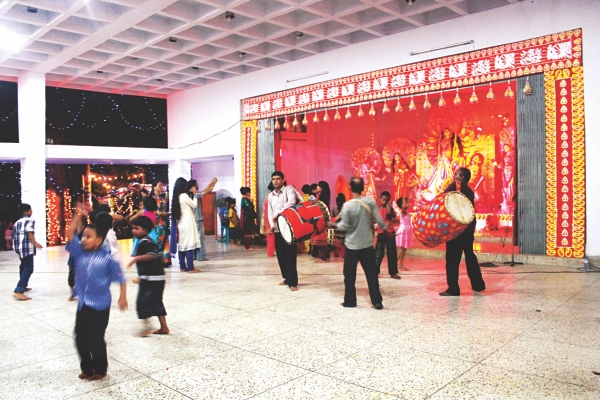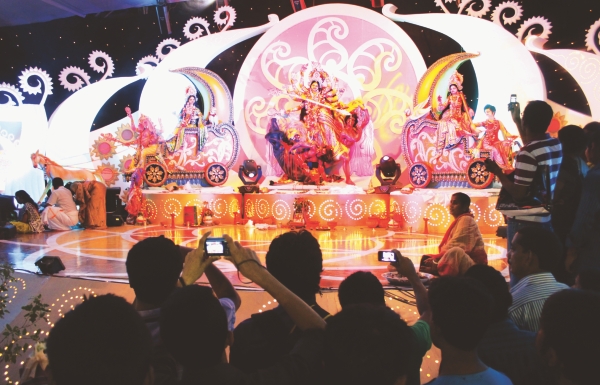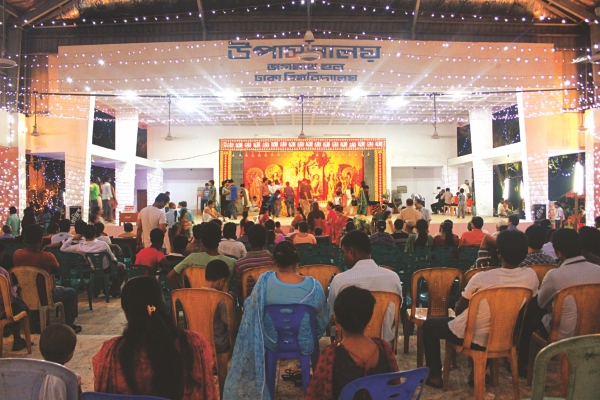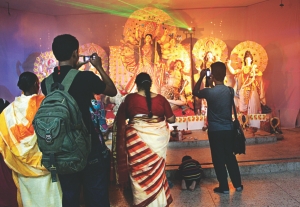Spotlight

Colours of Durga Puja
Naziba Basher
Photol: Kazi Tahsin Agaz Apurbo
"Maa ashche ghore” was a common saying during all the festivity the past week. With the passing of Eid-Ul-Fitr, the country had waited all this time for the celebrations of Durga Puja to arrive. Even though Durga Puja is celebrated in different styles all around, the basic aim of this celebration is to propitiate Shakti, the Goddess in Her aspect as Power, to bestow upon man all wealth, auspiciousness, prosperity, knowledge (both sacred and secular), and all other potent powers.

A sneak peak at the Pratima before Puja had begun.
Durga Puja is not simply about celebrations and feasting. The actual carousing of the Puja is all about enlightenment of the soul and the celebrations of the goodness over evil. It is about the triumph of truth over false and right over wrong. Durga Puja is about sustaining the mass belief of the emergence of an almighty saviour whenever evil tries to take over the goodness in the universe. So, the Puja is much beyond the glamour and glitter and the grandeur of the celebrations. In Dhaka City the young students celebrated Puja to the fullest, keeping the spirituality and respect for Maa Durga in mind. Whether going back to their home towns with the family, or staying here and visiting the various Puja'r mandaps, Durga Puja is definitely a festival worth waiting for for all of them.
 |
Students piling up in front of Maa Durga during the Puja. |
Dhaka Universitie's Jagannath Hall is the only University in Dhaka known to have their own Durga Puja celebrations. Decorating the hall with lights and different coloured cloths and of course their very own Pratima (statue of Maa Durga) is also present at the hall as she stands mighty and powerful with blessings to give out. Students of Dhaka University enjoy the atmosphere more than ever this time around, celebrating with friends and visiting the hall everyday of the Puja to see what else has been added to the festivity. Puja is a religious festival that brings everyone closer together irrespective of religion or race. It is a festival that displays togetherness and love, not just for who we worship but also for one another.
Ratul, a student of Dhaka University shares, "I love visiting Jagannath Hall during Durga Puja. The hype is unbelievable. There are people, young or old, taking blessings from Durga. It is a very joyous occassion and I love sharing that with my friends." Ratul, who happens to be a muslim, adds, “Even though, this is a Hindu festival, it is still something that I like to celebrate with my friends. Whether going to the Rama Krishna Mission to watch the Kumari Puja or going to a friend's place and enjoying the Puja delicacies, I like doing it all."
Durga Puja is celebrated in 5 days-- Sashti, Shaptami, Ashthami, Nabami and Dashami. The five festive Puja days are celebrated along with rituals, dhak, dhunuchi and so much more.

The dhuli's playing the dhak while greeting Maa Durga.
According to the mythology, Goddess Durga arrives to the mortal world from her heavenly adobe, with her children on Sashti. Her arrival on earth is welcomed by the devotees with much fanfare, amidst the beats of dhak. The main ritual carried on this day is the unveiling of the face of the idol of Goddess Durga. The rituals of Bodhon, Amontron and Adibas are performed before the commencement of the Puja.
With the first rays of the sun on Shaptami, a tree is dressed as the Goddess Durga herself in yellow silk cloth with a red border. The tree deemed to be the Goddess then becomes the spotlight attraction for the rest of the festival. The priest carries the tree in a grand procession to the Durga Puja mandap (platform) accompanied by the drummers to welcome the Goddess. A platform is set up with an idol of Lord Ganesha already seated there. The tree-goddess is then installed beside the God of good fortune and then worshipped. The Kola Bow or Nabapatrika receives a holy bath, which is performed well before the dawn, on Shaptami. In this ritual, nine types of plants are worshipped as a symbol of Goddess Durga.
 |
Jagannath Hall decorated for Durga Puja. |
There were different stalls in different Puja Mandaps. |
The next day, or Ashtami, was traditionally the buffalo sacrifice day to commemorate the victory of the Goddess over the buffalo-demon, Mahishasura. However, there are no more sacrifices on the day. During Ashtami, the devotees offer anjali (lamps) to the deity. The worship of little girls, called 'Kumari Puja', is the main attraction of the day. In the evening, Sandhi Puja is conducted, which marks the inter-linking of Ashtami with Nabami.

The gathering of believers during Durga Puja is overwhelming as they wait for her blessings.
Nabami, the ninth day, is the main day of Durga Puja. The day begins after the end of Sandhi Puja. Merriment, music and dance fill the rest of the day. On Nabami, the nabami bhog (offering of sweets) is offered to the deity. This food takes the shape of Prasad, which is eaten by the devotees.
 |
Taking a picture of one of the many uniquely made Pratima's. |
Dashami is the last day of Durga Puja, when a tearful farewell is offered to the deity. This process is called Bisarjan, wherein a grand send-off is arranged by the devotees. The idol of Goddess Durga, amidst a long procession of devotees, is brought to the nearest river or lake (in Dhaka, it is mostly river Buriganga) to immerse it. This event is also called Bijoya Dashami. 'Shidur Khela' is a major event of Dashami. Married women apply vermilion to each other and greet each other with sweets.
During these six days, young students all over Bangladesh take part in the grand celebrations starting from greeting Maa Durga to bidding farewell to her. As some of us may join in the celebrations and enjoy it's festivities, to others it is more of a spiritual moment more than anything.
"To me, Durga Puja is a spiritual time. As much as I like celebrating and having fun with friends and family, I also love the feeling of the blessings that I am getting from Maa Durga. Her presence itself makes me feel loved and blessed. Knowing that she is there watching over me is a completely indescribable feeling" says Shurovi, from East West University. She adds, "But apart from that, yes, I love celebrating! I love the colours and the lights. I go with my friends to celebrate every day of Puja to places like Jagannath Hall or Rama Krishna Mission. And then bring them back home for some delicious Puja treats which they also love!"

Jagannath Hall's Durga Puja decorations, platform and Pratima.
The food during Durga Puja is another thing that youngsters crave amidst all the celebrations. Specific items are needed for each day of Durga Puja. Things starting from Panchashasha (grains of five types) to Aakher Rosh (sugarcane juice) are used just during Kalparambho, a ritual preformed before the commencement of Puja. Throughout the other days of Puja, fruits and sweets and other delicacies are important according to each day of Puja signifying the importance of the day in their own ways. And of course, the young favourites have to be the overwhelming amounts of malpoa, naru, shondesh and other kinds of sweets that one awaits for to add to the already exciting festival.
 |
Students of Jagannath Hall and other visitors admiring
the work done at the hall for the Puja. |
"Apart from all the different Puja food we eat at our friends' places, my favourite part has to be the sweets. All the different kinds of sweets are just overwhelming. I never know which one to eat first!" says Nafis from American International University of Bangladesh. "The best part about Puja to me, apart from all us friends hanging out together and being a part of the celebrations, is when my friends bring back more Puja delicacies from their visits to their hometown!" Nafis adds.
As we bid farewell to Maa Durga, some of us are sad to have to say goodbye to their Mother who had come to bless them and protect them from evil, some of us are excited for Maa Durga's arrival again next year while some of us can't wait to feast on our friends' mothers' homemade sweets again. Whatever it may be, Dashami and the other days of Durga Puja hold their own significance in everyone's hearts, despite race or religion.
Whether it is the sheer excitement that the beats of the dhak brings right from Sashti, or waiting to see who the Kumari will be during Ashtami, Durga Puja is always full of pleasant surprises along with a splash of colour and the rhythmic beats playing here and there and the students and young people of Dhaka City were out there making the most out of it this year!

| 